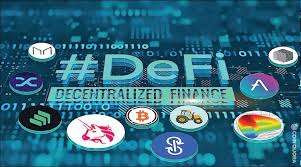The financial landscape is undergoing a major transformation, with decentralized finance (DeFi) at the forefront of this change. Unlike traditional banking systems, DeFi leverages blockchain technology to offer open, permissionless, and borderless financial services. The rise of this innovative ecosystem is not just about cryptocurrencies—it’s about reshaping how we interact with financial products and services. In this article, we will explore the technological foundations that make DeFi possible and how they are revolutionizing global finance.
Understanding Decentralized Finance (DeFi)
Decentralized finance, often referred to as DeFi, is a financial system built on blockchain technology that removes the need for intermediaries like banks or brokers. Instead, it uses smart contracts to automate financial transactions, making processes more transparent, efficient, and accessible to everyone worldwide.
The DeFi ecosystem includes various applications such as lending and borrowing platforms, decentralized exchanges (DEXs), stablecoins, yield farming, and staking protocols. These innovations have created an alternative financial system that operates on a global scale, providing financial services to the unbanked and underbanked populations.
The Core Technologies Behind DeFi
Several groundbreaking technologies support the DeFi ecosystem, ensuring security, efficiency, and transparency in financial transactions. Some of the most important technologies include:
1. Blockchain Networks
At the core of DeFi lies blockchain technology, a decentralized ledger that records transactions in a secure and immutable manner. Blockchains such as Ethereum, Binance Smart Chain, and Solana serve as the foundation for DeFi applications.
Ethereum, in particular, has been instrumental in the rise of DeFi due to its smart contract capabilities, which enable developers to build decentralized applications (dApps) that function without centralized control. As blockchain scalability improves, DeFi is expected to become even more efficient and widely adopted.
2. Smart Contracts
Smart contracts are self-executing contracts with terms and conditions written in code. These contracts automatically execute transactions when predefined conditions are met, eliminating the need for intermediaries.
For example, in DeFi lending protocols like Aave or Compound, smart contracts handle loan issuance, interest calculations, and repayments, all without human intervention. This reduces costs, increases security, and ensures seamless operations in financial transactions.
3. Decentralized Exchanges (DEXs)
Traditional financial markets rely on centralized exchanges, which control user funds and facilitate transactions. In contrast, DeFi introduces decentralized exchanges (DEXs) such as Uniswap, SushiSwap, and PancakeSwap, where users can trade digital assets directly from their wallets.
DEXs utilize automated market makers (AMMs) instead of traditional order books, allowing for permissionless, peer-to-peer trading. This removes the risks associated with centralized platforms, such as hacking or mismanagement of funds.
4. Oracles and Real-World Data Integration
DeFi applications often require access to real-world data, such as asset prices or interest rates, to function accurately. Blockchain oracles, like Chainlink and Band Protocol, provide this crucial data by acting as bridges between on-chain and off-chain information.
For instance, DeFi insurance platforms use oracles to verify real-world events, while lending protocols rely on them for accurate price feeds to determine loan collateralization ratios.
Security Challenges in DeFi
While DeFi brings numerous advantages, it is not without risks. Security remains one of the biggest concerns, with issues such as smart contract vulnerabilities, flash loan attacks, and rug pulls affecting the industry.
To mitigate these risks, developers conduct rigorous smart contract audits, employ bug bounty programs, and implement decentralized governance models. Additionally, insurance protocols such as Nexus Mutual offer coverage for DeFi users against potential losses caused by security breaches.
The Role of DeFi in Financial Inclusion

One of the most promising aspects of decentralized finance is its ability to promote financial inclusion. Traditional banking systems often exclude millions of people due to high fees, geographic barriers, or strict regulatory requirements. DeFi eliminates these barriers by providing open and permissionless access to financial services through a simple internet connection.
People in developing countries can use DeFi applications for savings, loans, and investments without needing a bank account. Additionally, stablecoins, which are pegged to fiat currencies, offer a reliable store of value for those living in countries with unstable economies or high inflation rates.
Future Trends in DeFi
As the DeFi ecosystem matures, several trends are shaping its future. Some of the key developments to watch for include:
1. Layer 2 Scaling Solutions
High gas fees and slow transaction speeds on networks like Ethereum have led to the rise of Layer 2 solutions, such as Optimistic Rollups and zk-Rollups. These technologies improve transaction efficiency and reduce costs, making DeFi more accessible to a broader audience.
2. Cross-Chain Compatibility
Interoperability between different blockchain networks is becoming increasingly important for DeFi adoption. Projects like Polkadot, Cosmos, and Thorchain are working to enable seamless asset transfers across multiple chains, enhancing liquidity and usability.
3. Institutional Adoption
As regulatory clarity improves, institutional investors are beginning to explore DeFi opportunities. Traditional financial institutions are integrating blockchain technology into their operations, with some launching their own DeFi services to cater to a growing digital asset market.
4. Decentralized Identity Solutions
Privacy and security remain significant concerns in DeFi. Decentralized identity solutions aim to provide users with secure, verifiable identities without compromising anonymity. This could enhance trust and compliance within the DeFi ecosystem.
Conclusion
Decentralized finance is revolutionizing the financial sector by offering transparent, efficient, and inclusive financial services. With advancements in blockchain technology, smart contracts, and decentralized applications, DeFi is poised to redefine the future of global finance.
Despite challenges such as security vulnerabilities and regulatory uncertainties, ongoing innovations are paving the way for a more robust and accessible financial system. As DeFi continues to evolve, it holds the potential to democratize finance, empower individuals worldwide, and shape the financial landscape of tomorrow.
